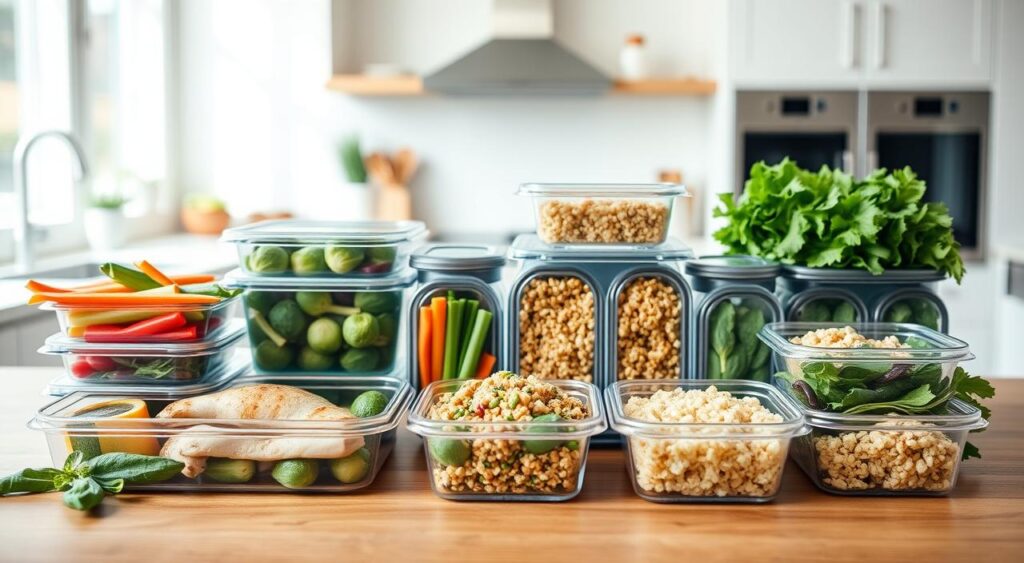Ever thought a low-carb diet could help diabetics lose weight? Finding the right diet can be tough. This article is your guide to a diabetic meal plan for weight loss.
It shows how to manage diabetes and lose weight slowly. You’ll get tips, recipes, and advice to help you reach your goals. Your weight loss journey can be both effective and lasting.
Understanding the Importance of Diet in Diabetes Management
A well-planned diabetic diet plan is key for managing diabetes well. What you eat greatly affects your blood sugar and health. Eating a balanced diet at set times helps keep your glucose stable, lowering the chance of big spikes.
Eating foods rich in nutrients and watching your portions is important. This helps avoid diabetes complications and keeps you healthy for a long time. A healthy meal plan makes sure you get all the vitamins and minerals your body needs.
Being active in your diet is a big step in managing diabetes. Regular talks with healthcare experts help you understand what you need to eat. Their advice can greatly improve your diabetes management journey.
What is a Diabetic Meal Plan for Weight Loss?
A diabetic meal plan for weight loss helps manage diabetes and lose weight. It focuses on balanced nutrition without affecting blood sugar levels. It includes low carbs, portion control, and nutrient-rich foods for lasting weight loss.
Defining the Core Components
The key parts of a weight loss meal plan for diabetics are:
- High fiber foods: Eat lots of veggies, fruits, and whole grains for better digestion.
- Lean proteins: Choose chicken, fish, and legumes to keep muscles strong and fat low.
- Healthy fats: Use avocados, nuts, and olive oil for heart health without sugars.
These elements help keep blood sugar stable and make you feel full. They are essential for a good diabetic diet plan.
Key Differences from Regular Meal Plans
A diabetic meal plan for weight loss focuses on managing blood sugar and losing weight. Unlike regular plans, it limits high carb foods. Instead, it uses low glycemic index foods for slow glucose release.
This helps prevent blood sugar spikes and improves metabolic control. For more on meal strategies, visit this informative resource.
Benefits of a Low-Carb Diet for Diabetics
Starting a low-carb diet can greatly benefit those with diabetes. It offers many advantages that can help you make better food choices. These choices are key to reaching your health goals.
Weight Loss and Blood Sugar Control
One big plus of a low-carb diet is it helps with weight loss. It also makes it easier to control blood sugar levels. People in diabetic weight loss programs often see their blood sugar stay more stable.
This is because they eat fewer carbs. Keeping blood sugar stable is very important for staying healthy.
Reducing HbA1c Levels and Heart Disease Risks
Studies show that a low-carb diet can lower HbA1c levels. Lowering your HbA1c is essential for managing diabetes long-term. It also helps reduce the risk of heart disease, a big concern for diabetics.
Choosing a low-carb diet can lead to a healthier life. It’s a step towards a better future.
Creating a Balanced Low-Carb Meal Plan
Creating a low carb meal plan for diabetes needs careful planning. Focus on a variety of nutritious foods with low carbs. Include fresh veggies, lean proteins, and healthy fats in your diet.
Plan your meals and snacks ahead to avoid unhealthy eating. This way, you stick to your diet goals. Make a grocery list with nutrient-rich foods to support your health and diabetes management.

Here’s a simple framework to help you create a balanced low-carb meal plan:
| Meal | Examples | Carbohydrate Content (Approx.) |
|---|---|---|
| Breakfast | Scrambled eggs with spinach and avocado | 5g |
| Lunch | Grilled chicken salad with mixed greens and olive oil dressing | 8g |
| Dinner | Baked salmon with asparagus and a side of quinoa | 15g |
| Snacks | Cucumber slices with hummus or a handful of nuts | 6g |
This table shows how to plan your meals with low carbs. A well-planned low carb meal plan can boost your energy and health. It’s key to managing diabetes successfully.
Healthy Diabetic Meal Plan: Getting Started
Starting a healthy diabetic meal plan can change your life. Everyone’s diet needs are different. So, it’s key to get advice from your healthcare team.
They can make a plan just for you. This includes tips for losing weight with diabetic meal prep.
Consulting with Your Healthcare Team
Your healthcare team is vital in creating a meal plan for you. They help make it fit your health needs. They consider what you can and can’t eat.
They also help balance carbs, proteins, and fats. This keeps your blood sugar in check.
Establishing a Routine Eating Schedule
Having a set meal time helps control blood sugar. It helps your body use insulin better. This keeps your energy up and hunger down.
It makes following your meal plan easier. A routine helps you plan better and reach your weight loss goals.
How to Simplify Meal Planning with the Diabetes Plate
The diabetes plate method makes meal planning easy. It lets you see how much food you’re eating without complicated math. It’s perfect for those on a diabetic meal plan for weight loss.
Start with a nine-inch plate. Fill half with non-starchy veggies. These are low in calories but packed with nutrients. They give you the vitamins you need and keep carbs in check.
Then, put a quarter of the plate for lean proteins like chicken or fish. Protein is good for muscles and keeps blood sugar stable. This is key for managing diabetes well.
Lastly, use the last quarter for quality carbs. Choose whole grains, legumes, or fruits. They give you energy and fit into your diabetic meal plan for weight loss.
- Visual Portion Control: It simplifies meal prep.
- Balanced Nutrition: You receive diverse food groups.
- Easy Tracking: Helps in monitoring food intake.
Using the diabetes plate method means you can eat well and manage diabetes. It also helps you reach your weight loss goals.
Diabetic Friendly Recipes for Weight Loss
Finding tasty and healthy meals is easy with diabetic friendly recipes for weight loss. Adding low-carb dishes to your diet keeps your taste buds happy and supports your health. Here are some great ideas for breakfast, lunch, and dinner that fit a low carb meal plan for diabetes.
Examples of Low-Carb Breakfast Options
- Vegetable Omelets: Full of spinach, bell peppers, and cheese, this dish is a protein-packed start to your day.
- Greek Yogurt with Nuts: A mix of creamy and crunchy, choose unsweetened Greek yogurt with your favorite nuts.
- Avocado Toast: Top whole grain bread with smashed avocado, a bit of salt, and chili flakes for a kick.
Delicious Lunch and Dinner Ideas
- Grilled Chicken Salad: Mix grilled chicken with leafy greens, tomatoes, olive oil, and vinegar for a fresh meal.
- Baked Salmon with Vegetables: This dish is not only tasty but also full of healthy fats, perfect for a low-carb meal.
- Zucchini Noodles with Pesto: Replace traditional pasta with zucchini noodles and add homemade or store-bought pesto for a lighter choice.
Tips for Healthy Snacking in Your Diabetic Diet
Keeping a healthy diabetic meal plan means watching what you eat, including snacks. Snacking can help control hunger and keep blood sugar stable. It’s important to choose snacks wisely and know the difference between hunger and thirst.
Identifying Real Hunger vs. Thirst
It’s easy to confuse thirst with hunger. If you feel like snacking, try drinking water first. Drinking enough water can help you feel full and may stop unnecessary snacking.
Choosing Nutritious Snack Options
A good diabetic diet includes snacks that are full of nutrients but don’t raise blood sugar too much. Here are some good snack ideas:
- Fruits paired with nuts: Try apples with almond butter or berries with walnuts. They’re full of fiber, healthy fats, and vitamins.
- Vegetables with hummus: Dipping carrots, cucumbers, or bell peppers in hummus is a great way to get more vitamins and minerals.
- Greek yogurt with seeds: Mixing Greek yogurt with chia seeds or flaxseeds adds protein and helps you feel full.

Understanding Your Carbohydrate Needs
Everyone’s body needs different amounts of carbs, based on how active you are, your age, and weight. It’s important to adjust your diet to fit these needs, which is key for managing diabetes. Looking into the various low-carb diets can help you find the right one for you.
Different Types of Low-Carb Diets
Low-carb diets vary a lot in how they handle carbs. Here are some common ones:
- Moderate Low-Carb Diet: A balanced option that lets you eat more carbs than usual diets but less than normal.
- Ketogenic Diet: This diet cuts carbs way down, making your body go into ketosis.
- Atkins Diet: It starts with a strict carb limit, then slowly adds more carbs back in.
- Paleo Diet: It focuses on eating whole foods and avoids processed foods, which often means eating fewer carbs.
How to Monitor and Manage Carb Intake
It’s key to keep track of how many carbs you eat. Here are ways to do that:
- Write down what you eat in a food diary, noting the carbs in each meal.
- Use apps on your phone to track what you eat and its nutritional info.
- Eat more veggies and whole grains to make sure you get enough nutrients.
- Talk to a doctor or dietitian to make a plan that fits your life and health goals.
Meal Prep Ideas for Weight Loss
Preparing meals ahead of time can change the game for those aiming to lose weight with diabetes. It saves time and keeps healthy food options ready. This makes sticking to a weight loss meal plan easier. Here are some tips and simple recipes to start with.
Batch Cooking and Storage Tips
Batch cooking lets you make big batches of food and portion them out. Here are some tips for successful meal prep:
- Choose a day each week for meal prep, like Sundays, to keep a routine.
- Use clear, airtight containers to store meals. This keeps food fresh and makes it easy to see what you have.
- Label containers with meal names and dates to avoid confusion.
- Choose recipes that freeze well, like soups and stews.
Quick and Easy Meal Prep Recipes
Here are some quick recipes that are nutritious and require few ingredients. Adding these to your meal prep can make food choices easier during the week.
| Recipe | Ingredients | Prep Time |
|---|---|---|
| Vegetable Stir-Fry | Mixed vegetables, olive oil, soy sauce, garlic | 15 minutes |
| Quinoa Salad | Quinoa, cherry tomatoes, cucumber, lemon juice, feta cheese | 20 minutes |
| Chicken and Broccoli Bake | Chicken breast, broccoli, cheddar cheese, spices | 30 minutes |
| Lentil Soup | Lentils, carrots, celery, vegetable broth, seasonings | 25 minutes |
Feel free to adjust these recipes to your liking. Try new spices or veggies to make them your own. Meal prep can change how you view daily meals, helping with health and weight loss. For more on creating a balanced diabetic meal plan, visit this link.

Staying Motivated on Your Weight Loss Journey
Sticking to a diabetic weight loss program can greatly improve your health. It’s key to keep motivated by setting goals and checking your progress often. This way, you’ll feel a sense of achievement, making it easier to stay on track.
Setting Realistic Goals
Setting realistic goals helps you reach bigger milestones. Instead of aiming for big weight loss, start with small steps. For instance:
- Try to lose 1-2 pounds each week.
- Slowly add healthier foods to your diet.
- Start exercising three times a week.
Every small win boosts your commitment to your weight loss plan. It shows you’re serious about achieving your goals.
Tracking Your Progress
Tracking your progress helps you stay accountable. You can use tools like:
- A food diary to track what you eat and why.
- Weight loss apps for insights and stats.
- Regular weigh-ins to see how you’re doing.
Keeping a record of your successes reminds you of your progress. It gives you motivation and helps you adjust your plan as needed. Regularly tracking your progress can make your weight loss journey feel more empowering and less scary.
Potential Risks and Considerations for a Low-Carb Diet
A low-carb diet can help with diabetes and weight management. But, it’s important to know the risks. These include nutrient deficiencies and digestive problems. Getting the right advice helps you deal with these issues.
Possible Side Effects to Be Aware Of
Starting a low-carb diet can cause several side effects. These include:
- Nutrient Deficiencies: Eating fewer carbs can mean missing out on important vitamins and minerals.
- Digestive Issues: You might get constipated or have bowel changes because of less fiber.
- Low Energy Levels: Your body might feel tired as it gets used to burning fat for energy.
- Possible Mood Changes: You could feel irritable or moody as you adjust to eating less carbs.
Consulting with a Dietitian for Personalized Advice
It’s wise to talk to a dietitian before changing your diet. They can give you advice that fits your health needs. They’ll help you understand the risks and create a balanced meal plan.
Working with a professional is key, even more so if you’re on diabetes meds. They might need to be adjusted based on your new diet.

Success Stories: Transformations with Diabetic Meal Plans
Listening to success stories from those who followed a diabetic weight loss program can really motivate you. These stories show how meal plans can lead to big changes. People have lost weight and better managed their blood sugar.
In a supportive community, people share their struggles and wins. This sharing boosts motivation and creates a sense of belonging. Each story proves the program’s success, showing how discipline can improve health.
Some people lost a lot of weight in just a few months, greatly improving their health. Each story is unique, showing how a diabetic meal plan can lead to a healthier life. By sticking to these diets, people regain their energy and confidence.
| Name | Weight Lost (lbs) | Duration (months) | Diabetes Management |
|---|---|---|---|
| Emily | 30 | 6 | Reduced medication dosage |
| Mark | 45 | 5 | Achieved normal blood sugar levels |
| Sara | 25 | 4 | Improved HbA1c readings |
| James | 50 | 7 | Increased energy levels |
These inspiring changes show that with hard work and the right help, you can succeed. Hearing these stories can motivate you to start your own journey and see positive changes in your life.
Conclusion
Starting a diabetic meal plan for weight loss is a smart move for your health. It’s not just about cutting calories. It’s about choosing foods that fit your health needs. This way, you can eat a variety of foods and reach your health goals.
This journey is for the long haul. By eating low-carb meals and sticking to a routine, you’re on the right path. Getting help from health experts can make your plan even better. They can make sure it fits your needs perfectly.
Every little change is important. Celebrate each step as you follow a diabetic meal plan. It’s not just about what you eat. It’s about finding a healthier, happier way of living.















4 Responses